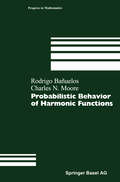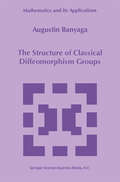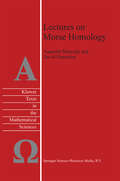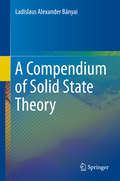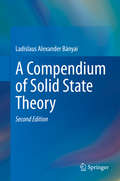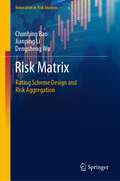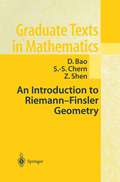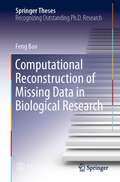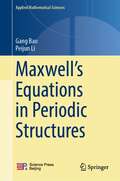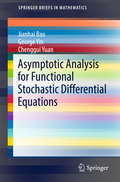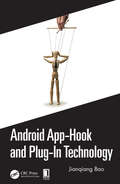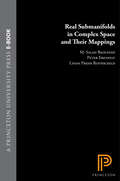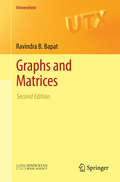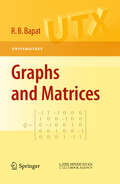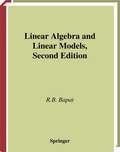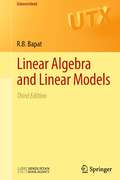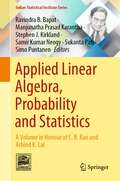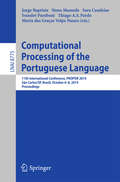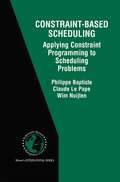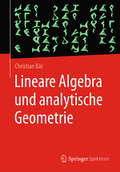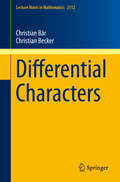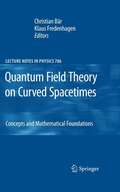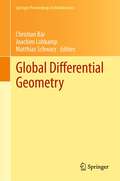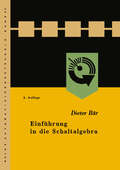- Table View
- List View
Probabilistic Behavior of Harmonic Functions (Progress in Mathematics #175)
by Rodrigo Banuelos Charles N. MooreHarmonic analysis and probability have long enjoyed a mutually beneficial relationship that has been rich and fruitful. This monograph, aimed at researchers and students in these fields, explores several aspects of this relationship. The primary focus of the text is the nontangential maximal function and the area function of a harmonic function and their probabilistic analogues in martingale theory. The text first gives the requisite background material from harmonic analysis and discusses known results concerning the nontangential maximal function and area function, as well as the central and essential role these have played in the development of the field.The book next discusses further refinements of traditional results: among these are sharp good-lambda inequalities and laws of the iterated logarithm involving nontangential maximal functions and area functions. Many applications of these results are given. Throughout, the constant interplay between probability and harmonic analysis is emphasized and explained. The text contains some new and many recent results combined in a coherent presentation.
The Structure of Classical Diffeomorphism Groups (Mathematics and Its Applications #400)
by Augustin BanyagaIn the 60's, the work of Anderson, Chernavski, Kirby and Edwards showed that the group of homeomorphisms of a smooth manifold which are isotopic to the identity is a simple group. This led Smale to conjecture that the group Diff'" (M)o of cr diffeomorphisms, r ~ 1, of a smooth manifold M, with compact supports, and isotopic to the identity through compactly supported isotopies, is a simple group as well. In this monograph, we give a fairly detailed proof that DifF(M)o is a simple group. This theorem was proved by Herman in the case M is the torus rn in 1971, as a consequence of the Nash-Moser-Sergeraert implicit function theorem. Thurston showed in 1974 how Herman's result on rn implies the general theorem for any smooth manifold M. The key idea was to vision an isotopy in Diff'"(M) as a foliation on M x [0, 1]. In fact he discovered a deep connection between the local homology of the group of diffeomorphisms and the homology of the Haefliger classifying space for foliations. Thurston's paper [180] contains just a brief sketch of the proof. The details have been worked out by Mather [120], [124], [125], and the author [12]. This circle of ideas that we call the "Thurston tricks" is discussed in chapter 2. It explains how in certain groups of diffeomorphisms, perfectness leads to simplicity. In connection with these ideas, we discuss Epstein's theory [52], which we apply to contact diffeomorphisms in chapter 6.
Lectures on Morse Homology (Texts in the Mathematical Sciences #29)
by Augustin Banyaga David HurtubiseThis book offers a detailed presentation of results needed to prove the Morse Homology Theorem using classical techniques from algebraic topology and homotopy theory. The text presents results that were formerly scattered in the mathematical literature, in a single reference with complete and detailed proofs. The core material includes CW-complexes, Morse theory, hyperbolic dynamical systems (the Lamba-Lemma, the Stable/Unstable Manifold Theorem), transversality theory, the Morse-Smale-Witten boundary operator, and Conley index theory.
A Compendium of Solid State Theory
by Ladislaus Alexander BányaiDesigned to sit alongside more conventional established condensed matter physics textbooks, this compact volume offers a concise presentation of the principles of solid state theory, ideal for advanced students and researchers requiring an overview or a quick refresher on a specific topic.The book starts from the one-electron theory of solid state physics, moving through electron-electron interaction and many-body approximation schemes, to lattice oscillations and their interactions with electrons. Subsequent chapters discuss transport theory and optical properties, phase transitions and some properties of low-dimensional semiconductors. Throughout the text, mathematical proofs are often only sketched, and the final chapter of the book reviews some of the key concepts and formulae used in theoretical physics.Aimed primarily at graduate and advanced undergraduate students taking courses on condensed matter theory, the book serves as a study guide to reinforce concepts learned through conventional solid state texts. Researchers and lecturers will also find it a useful resource as a concise set of notes on fundamental topics.
A Compendium of Solid State Theory
by Ladislaus Alexander BányaiDesigned to sit alongside more conventional established condensed matter physics textbooks, this compact volume offers a concise presentation of the principles of solid state theory, ideal for advanced students and researchers requiring an overview or a quick refresher on a specific topic.The book starts from the one-electron theory of solid state physics, moving through electron-electron interaction and many-body approximation schemes, to lattice oscillations and their interactions with electrons. Subsequent chapters discuss transport theory and optical properties, phase transitions and some properties of low-dimensional semiconductors. This extensively expanded second edition includes new material on adiabatic perturbation theory, kinetic coefficients, the Nyquist theorem, Bose condensation, and the field-theoretical approach to non-relativistic quantum electrodynamics. Throughout the text, mathematical proofs are often only sketched, and the final chapter of the book reviews some of the key concepts and formulae used in theoretical physics.Aimed primarily at graduate and advanced undergraduate students taking courses on condensed matter theory, the book serves as a study guide to reinforce concepts learned through conventional solid state texts. Researchers and lecturers will also find it a useful resource as a concise set of notes on fundamental topics.
Risk Matrix: Rating Scheme Design and Risk Aggregation (Innovation in Risk Analysis)
by Chunbing Bao Jianping Li Dengsheng WuThis book focuses on discussing the issues of rating scheme design and risk aggregation of risk matrix, which is a popular risk assessment tool in many fields. Although risk matrix is usually treated as qualitative tool, this book conducts the analysis from the quantitative perspective. The discussed content belongs to the scope of risk management, and to be more specific, it is related to quick risk assessment. This book is suitable for the researchers and practitioners related to qualitative or quick risk assessment and highly helps readers understanding how to design more convincing risk assessment tools and do more accurate risk assessment in a uncertain context.
An Introduction to Riemann-Finsler Geometry (Graduate Texts in Mathematics #200)
by D. Bao S.-S. Chern Z. ShenThis book focuses on the elementary but essential problems in Riemann-Finsler Geometry, which include a repertoire of rigidity and comparison theorems, and an array of explicit examples, illustrating many phenomena which admit only Finslerian interpretations. "This book offers the most modern treatment of the topic …" EMS Newsletter.
Computational Reconstruction of Missing Data in Biological Research (Springer Theses)
by Feng BaoThe emerging biotechnologies have significantly advanced the study of biological mechanisms. However, biological data usually contain a great amount of missing information, e.g. missing features, missing labels or missing samples, which greatly limits the extensive usage of the data. In this book, we introduce different types of biological data missing scenarios and propose machine learning models to improve the data analysis, including deep recurrent neural network recovery for feature missings, robust information theoretic learning for label missings and structure-aware rebalancing for minor sample missings. Models in the book cover the fields of imbalance learning, deep learning, recurrent neural network and statistical inference, providing a wide range of references of the integration between artificial intelligence and biology. With simulated and biological datasets, we apply approaches to a variety of biological tasks, including single-cell characterization, genome-wide association studies, medical image segmentations, and quantify the performances in a number of successful metrics.The outline of this book is as follows. In Chapter 2, we introduce the statistical recovery of missing data features; in Chapter 3, we introduce the statistical recovery of missing labels; in Chapter 4, we introduce the statistical recovery of missing data sample information; finally, in Chapter 5, we summarize the full text and outlook future directions. This book can be used as references for researchers in computational biology, bioinformatics and biostatistics. Readers are expected to have basic knowledge of statistics and machine learning.
Maxwell’s Equations in Periodic Structures (Applied Mathematical Sciences #208)
by Gang Bao Peijun LiThis book addresses recent developments in mathematical analysis and computational methods for solving direct and inverse problems for Maxwell’s equations in periodic structures. The fundamental importance of the fields is clear, since they are related to technology with significant applications in optics and electromagnetics. The book provides both introductory materials and in-depth discussion to the areas in diffractive optics that offer rich and challenging mathematical problems. It is also intended to convey up-to-date results to students and researchers in applied and computational mathematics, and engineering disciplines as well.
Asymptotic Analysis for Functional Stochastic Differential Equations (SpringerBriefs in Mathematics)
by Jianhai Bao George Yin Chenggui YuanThis brief treats dynamical systems that involve delays and random disturbances. The study is motivated by a wide variety of systems in real life in which random noise has to be taken into consideration and the effect of delays cannot be ignored. Concentrating on such systems that are described by functional stochastic differential equations, this work focuses on the study of large time behavior, in particular, ergodicity.This brief is written for probabilists, applied mathematicians, engineers, and scientists who need to use delay systems and functional stochastic differential equations in their work. Selected topics from the brief can also be used in a graduate level topics course in probability and stochastic processes.
Android App-Hook and Plug-In Technology
by Jianqiang BaoThis book presents the Android plug-in technology used in Android development. This technology is widely used by a majority of Chinese internet companies, and is becoming more widely used worldwide. The book fully describes the history of Android plug-in technology, the installation and startup process, and new features of the Android plug-in technology. It also explores plug-in solutions for peripheral technologies. The book is designed to help Android app developers better understand the underlying technology of the Android system. Features Introduces Android system knowledge, including the communication between AMS and four components Describes the Hook technique by Proxy.newProxyInstance and reflection, to modify Android system behavior, for example, to launch an activity not declared in the AndroidManifest. Shows how to use the Hook apk packaging process in Gradle Covers how to merge the resources in the plugin app and the host app, and how to merge dex of the host app and all the plugin apps Presents the SO technique and how to launch SO files dynamically
Android App-Hook and Plug-In Technology
by Jianqiang BaoThis book presents the Android plug-in technology used in Android development. This technology is widely used by a majority of Chinese internet companies, and is becoming more widely used worldwide. The book fully describes the history of Android plug-in technology, the installation and startup process, and new features of the Android plug-in technology. It also explores plug-in solutions for peripheral technologies. The book is designed to help Android app developers better understand the underlying technology of the Android system. Features Introduces Android system knowledge, including the communication between AMS and four components Describes the Hook technique by Proxy.newProxyInstance and reflection, to modify Android system behavior, for example, to launch an activity not declared in the AndroidManifest. Shows how to use the Hook apk packaging process in Gradle Covers how to merge the resources in the plugin app and the host app, and how to merge dex of the host app and all the plugin apps Presents the SO technique and how to launch SO files dynamically
Real Submanifolds in Complex Space and Their Mappings (PMS-47)
by M. Salah Baouendi Peter Ebenfelt Linda Preiss RothschildThis book presents many of the main developments of the past two decades in the study of real submanifolds in complex space, providing crucial background material for researchers and advanced graduate students. The techniques in this area borrow from real and complex analysis and partial differential equations, as well as from differential, algebraic, and analytical geometry. In turn, these latter areas have been enriched over the years by the study of problems in several complex variables addressed here. The authors, M. Salah Baouendi, Peter Ebenfelt, and Linda Preiss Rothschild, include extensive preliminary material to make the book accessible to nonspecialists. One of the most important topics that the authors address here is the holomorphic extension of functions and mappings that satisfy the tangential Cauchy-Riemann equations on real submanifolds. They present the main results in this area with a novel and self-contained approach. The book also devotes considerable attention to the study of holomorphic mappings between real submanifolds, and proves finite determination of such mappings by their jets under some optimal assumptions. The authors also give a thorough comparison of the various nondegeneracy conditions for manifolds and mappings and present new geometric interpretations of these conditions. Throughout the book, Cauchy-Riemann vector fields and their orbits play a central role and are presented in a setting that is both general and elementary.
Graphs and Matrices (Universitext)
by Ravindra B. BapatThis new edition illustrates the power of linear algebra in the study of graphs. The emphasis on matrix techniques is greater than in other texts on algebraic graph theory. Important matrices associated with graphs (for example, incidence, adjacency and Laplacian matrices) are treated in detail.Presenting a useful overview of selected topics in algebraic graph theory, early chapters of the text focus on regular graphs, algebraic connectivity, the distance matrix of a tree, and its generalized version for arbitrary graphs, known as the resistance matrix. Coverage of later topics include Laplacian eigenvalues of threshold graphs, the positive definite completion problem and matrix games based on a graph.Such an extensive coverage of the subject area provides a welcome prompt for further exploration. The inclusion of exercises enables practical learning throughout the book.In the new edition, a new chapter is added on the line graph of a tree, while some results in Chapter 6 on Perron-Frobenius theory are reorganized.Whilst this book will be invaluable to students and researchers in graph theory and combinatorial matrix theory, it will also benefit readers in the sciences and engineering.
Graphs and Matrices (Universitext)
by Ravindra B. BapatGraphs and Matrices provides a welcome addition to the rapidly expanding selection of literature in this field. As the title suggests, the book’s primary focus is graph theory, with an emphasis on topics relating to linear algebra and matrix theory. Information is presented at a relatively elementary level with the view of leading the student into further research. In the first part of the book matrix preliminaries are discussed and the basic properties of graph-associated matrices highlighted. Further topics include those of graph theory such as regular graphs and algebraic connectivity, Laplacian eigenvalues of threshold graphs, positive definite completion problem and graph-based matrix games. Whilst this book will be invaluable to researchers in graph theory, it may also be of benefit to a wider, cross-disciplinary readership.
Linear Algebra and Linear Models (Universitext)
by Ravindra B. BapatThis book provides a rigorous introduction to the basic aspects of the theory of linear estimation and hypothesis testing, covering the necessary prerequisites in matrices, multivariate normal distribution and distributions of quadratic forms along the way. It will appeal to advanced undergraduate and first-year graduate students, research mathematicians and statisticians.
Linear Algebra and Linear Models (Universitext)
by Ravindra B. BapatLinear Algebra and Linear Models comprises a concise and rigorous introduction to linear algebra required for statistics followed by the basic aspects of the theory of linear estimation and hypothesis testing. The emphasis is on the approach using generalized inverses. Topics such as the multivariate normal distribution and distribution of quadratic forms are included.For this third edition, the material has been reorganised to develop the linear algebra in the first six chapters, to serve as a first course on linear algebra that is especially suitable for students of statistics or for those looking for a matrix theoretic approach to the subject. Other key features include: coverage of topics such as rank additivity, inequalities for eigenvalues and singular values; a new chapter on linear mixed models; over seventy additional problems on rank: the matrix rank is an important and rich topic with connections to many aspects of linear algebra such as generalized inverses, idempotent matrices and partitioned matrices.This text is aimed primarily at advanced undergraduate and first-year graduate students taking courses in linear algebra, linear models, multivariate analysis and design of experiments. A wealth of exercises, complete with hints and solutions, help to consolidate understanding. Researchers in mathematics and statistics will also find the book a useful source of results and problems.
Applied Linear Algebra, Probability and Statistics: A Volume in Honour of C. R. Rao and Arbind K. Lal (Indian Statistical Institute Series)
by Ravindra B. Bapat Manjunatha Prasad Karantha Stephen J. Kirkland Samir Kumar Neogy Sukanta Pati Simo PuntanenThis book focuses on research in linear algebra, statistics, matrices, graphs and their applications. Many chapters in the book feature new findings due to applications of matrix and graph methods. The book also discusses rediscoveries of the subject by using new methods. Dedicated to Prof. Calyampudi Radhakrishna Rao (C.R. Rao) who has completed 100 years of legendary life and continues to inspire us all and Prof. Arbind K. Lal who has sadly departed us too early, it has contributions from collaborators, students, colleagues and admirers of Professors Rao and Lal. With many chapters on generalized inverses, matrix analysis, matrices and graphs, applied probability and statistics, and the history of ancient mathematics, this book offers a diverse array of mathematical results, techniques and applications. The book promises to be especially rewarding for readers with an interest in the focus areas of applied linear algebra, probability and statistics.
Computational Processing of the Portuguese Language: 11th International Conference, PROPOR 2014, Sao Carlos/SP, Brazil, October 6-8, 2014, Proceedings (Lecture Notes in Computer Science #8775)
by Jorge Baptista Nuno Mamede Sara Candeias Ivandré Paraboni Thiago A. S. Pardo Maria Das Gracas Volpe NunesThis book constitutes the refereed proceedings of the 11th International Workshop on Computational Processing of the Portuguese Language, PROPOR 2014, held in Sao Carlos, Brazil, in October 2014. The 14 full papers and 19 short papers presented in this volume were carefully reviewed and selected from 63 submissions. The papers are organized in topical sections named: speech language processing and applications; linguistic description, syntax and parsing; ontologies, semantics and lexicography; corpora and language resources and natural language processing, tools and applications.
Constraint-Based Scheduling: Applying Constraint Programming to Scheduling Problems (International Series in Operations Research & Management Science #39)
by Philippe Baptiste Claude Le Pape Wim NuijtenConstraint Programming is a problem-solving paradigm that establishes a clear distinction between two pivotal aspects of a problem: (1) a precise definition of the constraints that define the problem to be solved and (2) the algorithms and heuristics enabling the selection of decisions to solve the problem. It is because of these capabilities that Constraint Programming is increasingly being employed as a problem-solving tool to solve scheduling problems. Hence the development of Constraint-Based Scheduling as a field of study. The aim of this book is to provide an overview of the most widely used Constraint-Based Scheduling techniques. Following the principles of Constraint Programming, the book consists of three distinct parts: The first chapter introduces the basic principles of Constraint Programming and provides a model of the constraints that are the most often encountered in scheduling problems. Chapters 2, 3, 4, and 5 are focused on the propagation of resource constraints, which usually are responsible for the "hardness" of the scheduling problem. Chapters 6, 7, and 8 are dedicated to the resolution of several scheduling problems. These examples illustrate the use and the practical efficiency of the constraint propagation methods of the previous chapters. They also show that besides constraint propagation, the exploration of the search space must be carefully designed, taking into account specific properties of the considered problem (e.g., dominance relations, symmetries, possible use of decomposition rules). Chapter 9 mentions various extensions of the model and presents promising research directions.
Lineare Algebra und analytische Geometrie
by Christian BärDas Werk bietet eine Einführung in die lineare Algebra und die analytische Geometrie und enthält Material für eine zweisemestrige Vorlesung. Es beginnt mit einem Kapitel, das allgemein in die mathematische Denkweise und Beweistechniken einführt, um dann über lineare Gleichungssysteme zur linearen Algebra überzuleiten. Besonderer Wert wird auf eine enge Verzahnung von algebraischen und geometrischen Konzepten gelegt, zum einen um eine gute geometrische Intuition für algebraische Begriffe zu entwickeln, zum anderen um elegante algebraische Beweismethoden für geometrische Sätze einsetzen zu können. Der Text ist klar und verständlich geschrieben und in einem erfrischenden Stil verfasst. Schließlich sind interaktive Übungsseiten und Illustrationen integriert, die zu einem aktiven Studium anregen.
Differential Characters (Lecture Notes in Mathematics #2112)
by Christian Bär Christian BeckerProviding a systematic introduction to differential characters as introduced by Cheeger and Simons, this text describes important concepts such as fiber integration, higher dimensional holonomy, transgression, and the product structure in a geometric manner. Differential characters form a model of what is nowadays called differential cohomology, which is the mathematical structure behind the higher gauge theories in physics.
Quantum Field Theory on Curved Spacetimes: Concepts and Mathematical Foundations (Lecture Notes in Physics #786)
by Christian Bär Klaus FredenhagenAfter some decades of work a satisfactory theory of quantum gravity is still not available; moreover, there are indications that the original field theoretical approach may be better suited than originally expected. There, to first approximation, one is left with the problem of quantum field theory on Lorentzian manifolds. Surprisingly, this seemingly modest approach leads to far reaching conceptual and mathematical problems and to spectacular predictions, the most famous one being the Hawking radiation of black holes. Ingredients of this approach are the formulation of quantum physics in terms of C*-algebras, the geometry of Lorentzian manifolds, in particular their causal structure, and linear hyperbolic differential equations where the well-posedness of the Cauchy problem plays a distinguished role, as well as more recently the insights from suitable concepts such as microlocal analysis. This primer is an outgrowth of a compact course given by the editors and contributing authors to an audience of advanced graduate students and young researchers in the field, and assumes working knowledge of differential geometry and functional analysis on the part of the reader.
Global Differential Geometry (Springer Proceedings in Mathematics #17)
by Christian Bär Joachim Lohkamp Matthias SchwarzThis volume contains a collection of well-written surveys provided by experts in Global Differential Geometry to give an overview over recent developments in Riemannian Geometry, Geometric Analysis and Symplectic Geometry.The papers are written for graduate students and researchers with a general interest in geometry, who want to get acquainted with the current trends in these central fields of modern mathematics.
